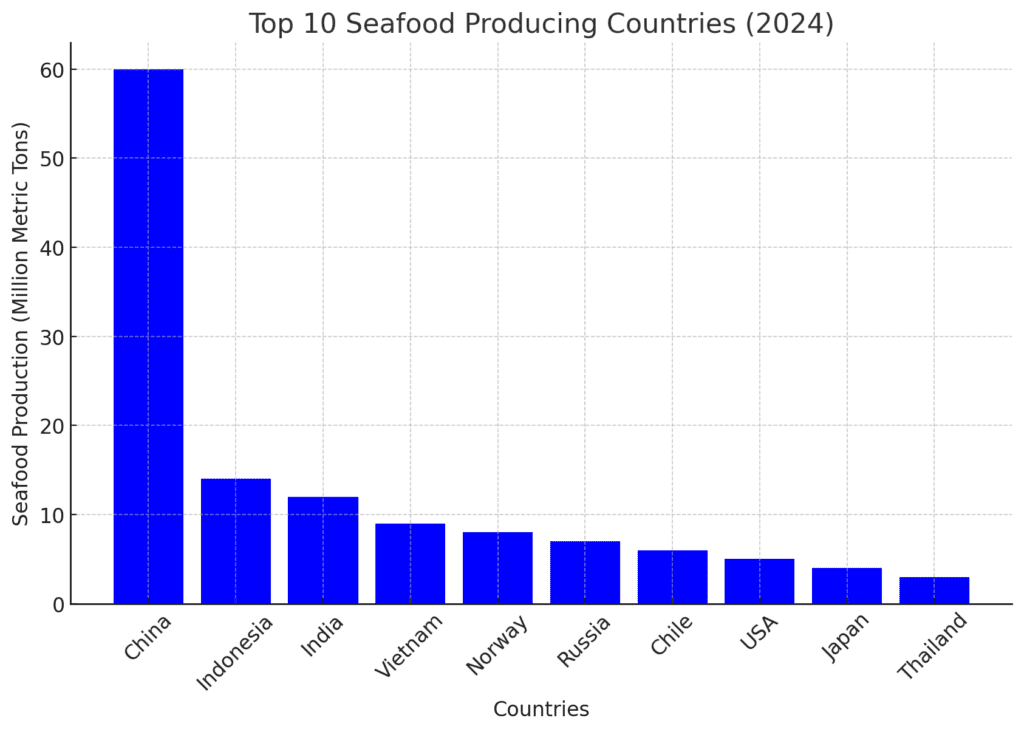Introduction
The global seafood industry is a cornerstone of the food sector, providing nutrition to billions worldwide. As a multi-billion-dollar market, seafood is an essential source of protein and economic livelihood for millions, from small-scale fishers to multinational corporations. The industry, however, faces several challenges, including climate change, overfishing, trade policies, and sustainability concerns. This report provides an in-depth analysis of the global seafood industry, highlighting key market trends, major players, emerging innovations, and future projections.

Market Overview
The global seafood industry is valued at over $160 billion, with projections indicating steady growth. According to industry reports, global seafood production surpassed 180 million metric tons in 2024, comprising wild-caught and aquaculture sources. The market is driven by increasing consumer demand for high-protein diets, sustainable seafood, and alternative seafood products.
Top Seafood Producing Countries
- China – The world’s largest seafood producer, processing over 60 million metric tons annually.
- Indonesia – A key supplier of tuna, shrimp, and crab.
- India – Dominates the shrimp export market, supplying major global markets.
- Vietnam – A top player in pangasius fish and shrimp exports.
- Norway – One of the leading suppliers of salmon and cod to the global market.
- Russia – A major exporter of whitefish, especially pollock.
- Chile – A key player in farmed salmon exports.
- United States – Produces a variety of seafood, including Alaskan salmon and shellfish.
- Japan – A major consumer and exporter of high-end seafood products like bluefin tuna.
- Thailand – A dominant seafood processor and exporter, especially for canned seafood products.
Seafood Trade and Major Importing Countries
Seafood is one of the most traded food commodities globally. The leading seafood importing countries include:
- United States – The largest seafood importer, with over $20 billion in annual seafood imports.
- Japan – A major seafood consumer, importing premium fish species.
- China – Balances exports with a growing import demand for high-value seafood.
- European Union – Countries like Spain, Italy, and France are major seafood importers.
- South Korea – High seafood consumption per capita drives strong import demand.
- Canada – A major buyer of high-quality seafood products.
Key Trends in the Seafood Industry
1. Growth of Aquaculture
Aquaculture now accounts for over 50% of global seafood production. The demand for farmed fish, shrimp, and shellfish is increasing as wild stocks become more depleted. Leading aquaculture species include:
- Salmon (Norway, Chile, Scotland)
- Tilapia (China, Indonesia, Egypt)
- Shrimp (India, Ecuador, Vietnam)
- Pangasius (Vietnam)
2. Rising Demand for Sustainable Seafood
Consumers are increasingly seeking sustainable and eco-friendly seafood options. Certifications such as:
- Marine Stewardship Council (MSC)
- Aquaculture Stewardship Council (ASC)
- Best Aquaculture Practices (BAP)
help consumers identify responsibly sourced seafood. Retailers and foodservice providers are also committing to sustainable sourcing practices.
3. Expansion of Plant-Based and Cultivated Seafood
The alternative seafood market is expected to grow exponentially. Companies such as Good Catch, BlueNalu, and Finless Foods are developing plant-based and cell-cultured seafood to address sustainability and overfishing concerns.
4. Adoption of Technology in Seafood Processing
Technological advancements, including blockchain for traceability, AI-powered quality control, and automated processing, are improving efficiency in the seafood industry. Blockchain helps track seafood from ocean to plate, ensuring transparency and fraud prevention.
5. Climate Change Impact on Fisheries
Climate change is affecting fish migration patterns, ocean temperatures, and acidification, leading to unpredictable seafood supplies. Nations are investing in climate-resilient aquaculture and sustainable fishing techniques to combat these challenges.

Major Challenges Facing the Seafood Industry
1. Overfishing and Illegal Fishing
Illegal, unreported, and unregulated (IUU) fishing costs the industry $23 billion annually and threatens fish stocks. Governments and organizations are implementing stricter regulations and monitoring systems.
2. Trade Barriers and Tariffs
Global seafood trade faces obstacles due to tariffs, sanctions, and changing trade policies. For example, the U.S.-China trade war led to increased tariffs on seafood products, impacting global supply chains.
3. Rising Costs of Seafood Production
Inflation, fuel prices, labor shortages, and supply chain disruptions have increased the cost of seafood production. Companies are investing in automated processing and alternative energy sources to reduce expenses.
4. Food Safety and Contamination Issues
Seafood is highly perishable, and concerns over contaminants like microplastics, mercury, and pathogens impact consumer confidence. Improved food safety measures and traceability are critical for industry growth.
Future Outlook for the Global Seafood Industry
Despite challenges, the global seafood industry is poised for growth, driven by increasing demand, sustainability initiatives, and technological advancements.
1. Increasing Demand for Premium Seafood
Consumers are willing to pay higher prices for premium seafood products, including sushi-grade fish, organic seafood, and sustainably farmed shellfish.
2. Expansion of Digital Seafood Marketplaces
Online seafood marketplaces are revolutionizing the industry, providing direct access to fresh and frozen seafood products with enhanced traceability.
3. Investment in Alternative Seafood Technologies
Plant-based and lab-grown seafood alternatives will disrupt the traditional seafood supply chain, reducing pressure on wild stocks.
4. Strengthening Global Seafood Supply Chains
Companies are focusing on resilient supply chains, integrating blockchain, AI, and automation to mitigate disruptions.
5. Strengthened Government Regulations
More countries are introducing stricter seafood trade regulations to prevent illegal fishing, enforce sustainability measures, and improve seafood quality control.
Conclusion
The global seafood industry is rapidly evolving, with sustainability, innovation, and consumer demand shaping the future. As the world shifts toward responsible seafood consumption, industry players must adapt by investing in sustainable aquaculture, alternative seafood, digitalization, and transparency measures. With strategic planning, technological adoption, and regulatory compliance, the seafood industry is set to flourish in the coming decades.



